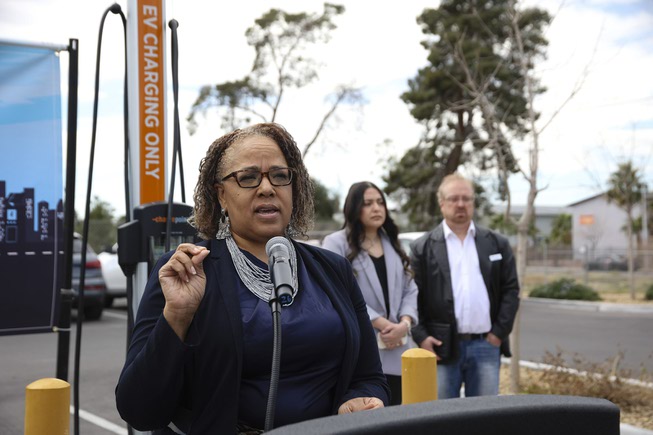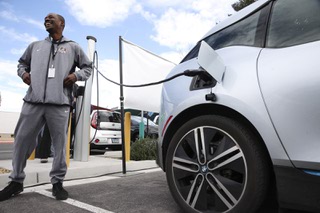
Senator Dina Neal (D-NV) speaks Thursday, Feb. 29, 2024 during a press conference held to ask the EPA and the Biden Administration to implement the strongest possible version of new light and medium vehicle emissions standards that go into effect in 2027.
Thursday, Feb. 29, 2024 | 7:16 p.m.
Local air quality and renewable energy advocates met with state Sen. Dina Neal today to urge the EPA and the Biden Administration to follow through on stricter emissions standards for automakers.
According to the EPA’s proposal, the new rules will apply to passenger cars, light trucks, larger trucks and vans in an effort to lower nitrous oxide and particulate matter emissions.
“The Biden administration and EPA have the opportunity to drastically reduce harmful air pollution and protect public health by finalizing the strongest possible cleaner car standards,” said Melissa Ramos, an American Lung Association Advocate.
East Las Vegas Library’s public electric charging station and a Tesla provided by the Nevada Electric Vehicle Association served as a backdrop for today’s event. The Southern Nevada Urban Heat Mapping Project shows the area is subject to the kind of dangerous heat that worsens air quality.
Mercedes McKinley, state coordinator for the advocacy group Moms Clean Air Force, said she grew up in the neighborhood, where nearby highways worsen air quality for residents. She said the asthma rate in the 89101 ZIP code stands at 11%, above the national average of 7.7% according to the US Centers for Disease Control.
“My daughter was born in this neighborhood, and I taught at an elementary school just up the street,” McKinley said. “My high school is two miles away. My daughter and other children in this country deserve a chance to breathe cleaner air than what we’re breathing today.”
Neal, D-North Las Vegas, said her daughter, Alexandra, contracted asthma while living near a part of Louisiana dubbed “cancer alley” because of the high number of fossil fuel operations near residential areas.
She said low-income areas with minority-majority populations like East Las Vegas often suffer worse rates of childhood asthma because of a combination of pollution and lack of health care.
“Every child that is born into this space will be impacted by how many pollutants are actually in the air,” Neal said. “This rule is going to change the narrative, and it’s going to change your perspective on what companies need to do and the standards they need to operate under.”
The new EPA standards would apply to vehicle models introduced starting in 2027 until 2032.
New standards for light-duty vehicle emissions would drop to 82 grams per mile of CO2 by 2032, just like standards adopted in 2021 would require, only faster. CO2 from vans and pickups would need to fall to an average of 275 grams per mile by 2032.
The proposals also include measures that would lower nitrous oxide and nonmethane organic gas admissions.
The EPA suggested automakers meet those targets by offering more electric vehicles and building more particulate filters and better CO2 tech into their internal combustion models.
“The proposed standards would contribute toward the goal of holding the increase in the global average temperature to well below 2°C above pre-industrial levels and reducing the probability of severe climate change-related impacts, including heat waves, drought, sea level rise, extreme climate and weather events, coastal flooding, and wildfires,” the announcement states.
The EPA estimates the proposal could save from $850 billion up to $1.6 trillion.

